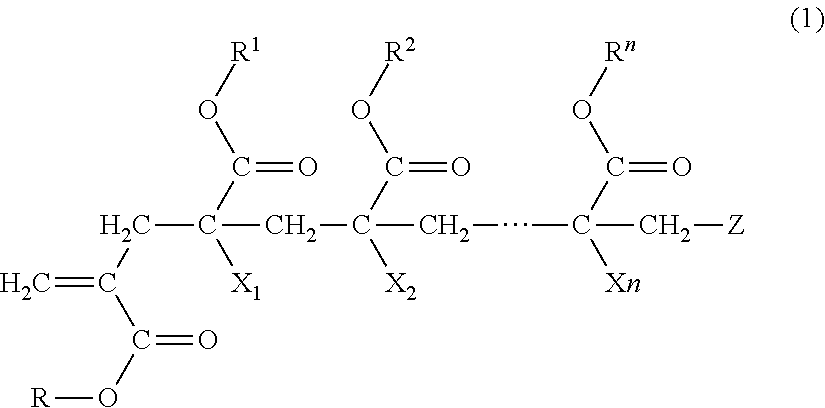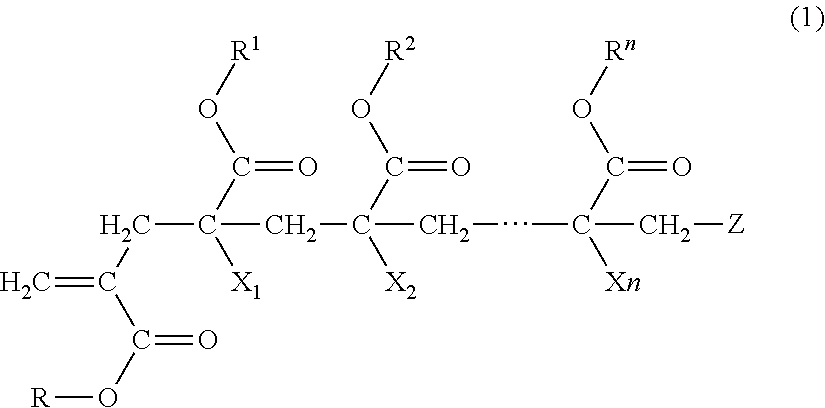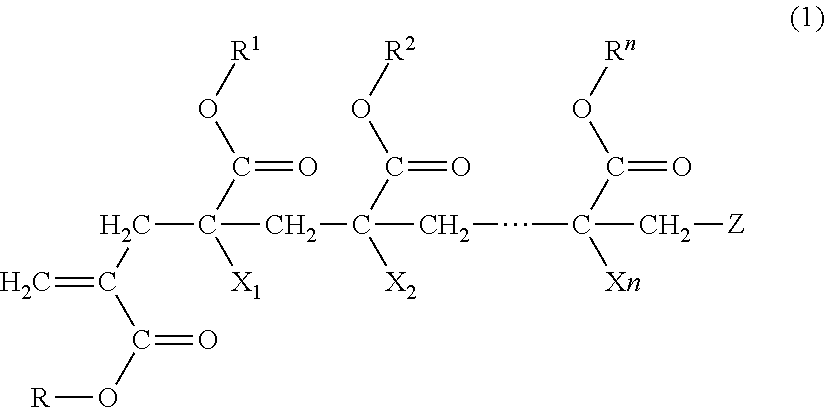Polymer and production method thereof, molding material and molded product
- Summary
- Abstract
- Description
- Claims
- Application Information
AI Technical Summary
Benefits of technology
Problems solved by technology
Method used
Image
Examples
Example
Production Example 1
Synthesis of Dispersion Agent (1)
[0145]To a reaction vessel (volume: 1200 L) equipped with a stirrer, a condenser, and a thermometer, 61.6 parts of 17% aqueous solution of potassium hydroxide, 19.1 parts of ACRYESTER M (product name, methyl methacrylate manufactured by Mitsubishi Rayon Co., Ltd.), and 19.3 parts of deionized water were added. Subsequently, the solution within the reaction vessel was stirred at room temperature, the exothermic peak was determined, and stirring was continued again for 4 hours. After that, the reaction solution within the reaction vessel was cooled to room temperature to obtain an aqueous solution of potassium methacrylate.
[0146]Subsequently, to a reaction vessel (volume: 1050 L) equipped with a stirrer, a condenser, and a thermometer, 900 parts of deionized water, 60 parts of ACRYESTER SEM-Na (product name, sodium 2-sulfoethyl methacrylate, manufactured by Mitsubishi Rayon Co., Ltd., 42% by mass aqueous solution), 10 parts of the a...
Example
Production Example 2
Synthesis of Chain Transfer Agent (1)
[0147]To an apparatus for synthesis equipped with a stirrer, 2.00 g (8.03 mmol) of cobalt (II) acetate tetrahydrate (manufactured by Wako Pure Chemical Industries, Ltd., Wako Special grade), 3.86 g (16.1 mmol) of diphenyl glyoxime (manufactured by Tokyo Chemical Industry Co., Ltd., EP grade), and 100 ml of diethyl ether from which oxygen has been removed in advance by nitrogen bubbling were added and stirred for 2 hours at room temperature.
[0148]Subsequently, 20 ml of diethyl ether boron trifluoride complex (manufactured by Tokyo Chemical Industry Co., Ltd., EP grade) was added and stirred again for 6 hours. The resultant was filtered, and the solid was washed with diethyl ether and dried for 12 hours at 20° C., 100 MPa or less to obtain 5.02 g (7.93 mmol, yield 99% by mass) of the chain transfer agent (1) as a brown solid.
Example
Production Example 3
Synthesis of Macromonomer (a-1)
[0149]To a polymerization apparatus equipped with a stirrer, a condenser, and a thermometer, 145 parts of deionized water, 0.13 part of sodium sulfate (Na2SO4), and 0.26 part of the dispersion agent (1) (solid content of 10% by mass) which has been prepared in Production Example 1 were added followed by stirring to obtain a homogenous aqueous solution. Next, 100 parts of ACRYESTER M, 0.0009 part of the chain transfer agent (1) which has been prepared in Production Example 2, and 0.1 part of PEROCTA O (product name, 1,1,3,3-tetramethylbutylperoxy2-ethylhexanoate manufactured by NOF CORPORATION) as a polymerization initiator were added to obtain an aqueous dispersion. Subsequently, the inside of the polymerization apparatus was fully flushed with nitrogen and the temperature of the aqueous dispersion was raised to 80° C. It was then maintained for 4 hours followed by raising the temperature to 92° C. at which the dispersion was mainta...
PUM
| Property | Measurement | Unit |
|---|---|---|
| Percent by mass | aaaaa | aaaaa |
| Percent by mass | aaaaa | aaaaa |
| Percent by mass | aaaaa | aaaaa |
Abstract
Description
Claims
Application Information
 Login to view more
Login to view more - R&D Engineer
- R&D Manager
- IP Professional
- Industry Leading Data Capabilities
- Powerful AI technology
- Patent DNA Extraction
Browse by: Latest US Patents, China's latest patents, Technical Efficacy Thesaurus, Application Domain, Technology Topic.
© 2024 PatSnap. All rights reserved.Legal|Privacy policy|Modern Slavery Act Transparency Statement|Sitemap



